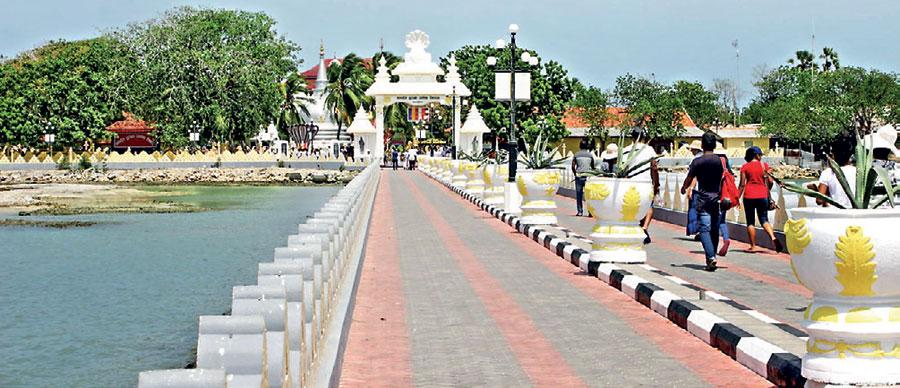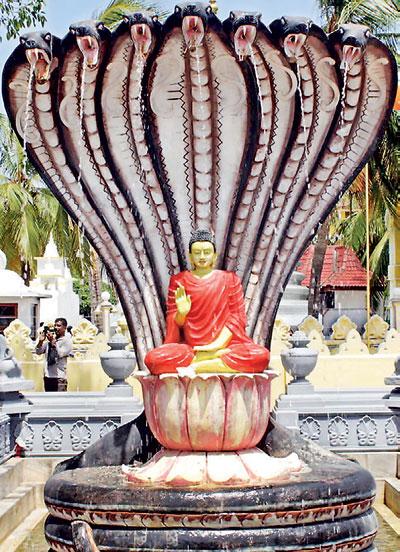Reply To:
Name - Reply Comment

Naga Viharaya in Jaffna
Five years after Enlightenment Gautama Buddha visited Sri Lanka for the second occasion. This visit was after His first visit to Sri Lanka to settle a dispute between Yakkhas and Nagas. Buddha’s second visit to Sri Lanka was on a ‘Bak’ Full Moon Poya Day. Nagas of Nagadeepa were divided as rivals. One group led by Naga king Mahodara “Big Tummy” and the other group led by his nephew Chulodara “Small Tummy” were up in arms. The bone of contention was a “Mini Palanga” – Gem throne- a seat made of gems.
Buddha, who was dwelling in Sevath Nuwara Dewram Vehera, with His devine eye envisaged an eminent destruction in a dreadful war. During that time the Northern and the Southern regions of this island were ruled by Nagas and the hill country by Devas. Naga king Mahodara who ruled the Northern region from Nagadeepa owned a gem throne. His sister’s son Chulodara too claimed ownership for the throne. He too had a large number of followers and both sides were equally strong. Neither of them was willing to give in. The destruction was inevitable in case of a war between the uncle and the nephew.
Buddha contemplated and saw that only He could be of assistance to both sides and prevent a war from being waged.
Accompanied by deity Samuddhi Saman, the Enlightened One proceeded to Nagadeepa in a bid to prevent the Naga rulers and their followers from getting one another destroyed.
In the words of the Omniscient One craving leads to destruction. Wealth destroys the fool, and not them who seek the goal .Through craving for wealth the fool harms not only himself, but also others.
- "Buddha saw that only He could be of assistance to both sides"
- "some people quarrel due to ignorance"
- "The Naga kings had built a shrine named “Rajayatana”
Only Buddha was able to bring under control Choladara and Mahodara. However, it was not possible to appease them merely by preaching. Hence the Exalted One created a dense darkness to make the Nagas realise the powers of their visitor. Nagas including Chulodara and Mahodara were scared because they had not experienced such a situation. They realised that Buddha possessed supernatural powers. The Enlightened One thus subjugated and brought to Nagas under control and the atmosphere created by Him was congenial for Him to direct them on to the correct path. When the Nagas were ready to listen to Buddha He preached Kokalika Jathakaya to make them realize that nothing could be gained by being rivals. Buddha made the Nagas realise that hatred is never appeased by hatred. It is appeased by non hatred. “Esa Dhammo Sanata no”
The Exalted One also made them realise that some people quarrel due to ignorance and that they do not gain anything but perish themselves by quarreling.
Buddha also made the Nagas realise that avariciousness leads to sorrow and fear. Those who have given up lust and avariciousness or extreme desire will be free from the pain of fear and sorrow.
 Reconciliation
ReconciliationBy making the Nagas realize these facts the Omniscient One was able to bring about reconciliation between the rival groups of Nagas. They became very pious and embraced Buddhism. The Nagas came to a conclusion and offered the gem throne to Buddha.
Reposed upon the Mini Palanga the Enlightened One preached Dhamma again. Thereupon the Nagas requested for an object for them to worship. The Exalted One gave them the Mini Palanga – the gem throne which had by then become a “Paribhogika Wasthu”- an item used by the Omniscient One.
These circumstances paved way for Buddha’s third visit to Lanka. “Maniakkhika” was the ruler of Kelaniya. He had gone to Nagadeepa to provide support to his nephew, Mahodara in the war. He too had been directed on to the correct path by Buddha. After listening to Dhamma from the Enlightened One, Naga king, Maniakkhika too embraced Buddhism and made an invitation to the Buddha to pay a visit to his kingdom, Kelaniya. The Enlightened One accepted the invitation and visited Sri Lanka for the third and the final occasion.
According to Mahavansa, the Buddha’s second visit is an important land mark in the history of Sri Lanka as it was the commencement of the civilization in this country.
The Naga kings had built a shrine named “Rajayatana” at the place where Buddha preached Dhamma. The area where the shrine was constructed was known during that time as Nagapattan. King Salendra of India too had built a Buddhist temple known as Naga Pattan. During the 1867 archaeological excavations a large number of Buddhist statues were recovered.
King Agga Bodhi the second, who was a devoted Buddhist, had renovated “Rajayathanaya Viharaya” and the Relic repository to facilitate devotes to worship. Close to the Jaffna peninsula there is a small island called Nainathiv. This island is also known as Nagadeepa. There is also a recently built temple in this island.Some Buddhists believe that this is the place where the Buddha had set foot on.
Prince Aritta, who requested him to send a sapling of Sri Maha Bodhi, had embarked at Dambakola (Jambukola).
Ruins of a Buddhist monastery were recovered from this place and the people of the area call this place Gothumalu which “means Bodhimlu in Sinhala. According to legendary evidence one of the eight sprigs of Sri Maha Bodhi (Atta maha phala) had been planted there.
The ruins of Buddhist temples have been recovered from Kandarodai village in the Jaffna peninsula. This place is mentioned in the Sinhala Nampotha as Kadurugoda Viharaya. This is believed to be the place where the Buddha preached Dhamma to Nagas.
It is also mentioned that momentos had been erected at places contacted by the Buddha. Thus there is sufficient information to presume that the place where the Buddha subjugated the Nagas is situated some miles away from Jambukola in Kankasanthurai in the direction of Anuradhapura.
This place in Nagadeepa made sacred by the touch of the Enlightened One is regarded as a place of worship by Buddhists. Naga Viharaya in Jaffna is maintained by the Maha Bodhi Society of Sri Lanka.